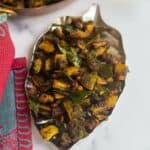Here is a simple South-Indian crispy bitter gourd stir-fry recipe that’s a perfect side dish for rice-based dishes! Check out how to make this simple pavakkai fry in a cast-iron pan with detailed step-wise pictures.
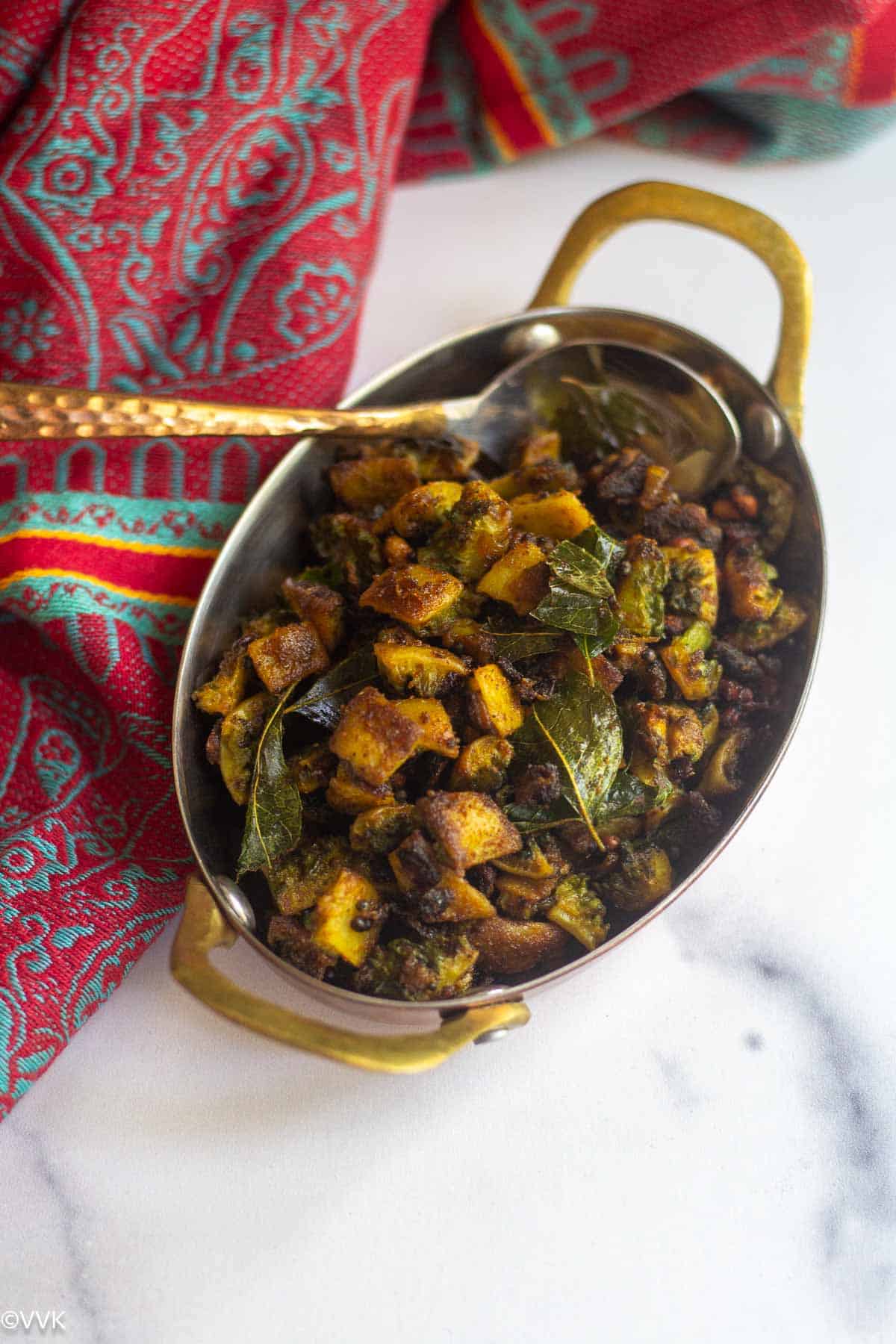
We call bitter gourd “pavakkai” in Tamil and “karela” in Hindi, though it’s also known as bitter melon or bitter squash. It’s a climbing vine, which I successfully cultivated in California. Despite its bitterness, bitter gourd is quite popular in Indian cuisine due to its remarkable health benefits. Since the internet is filled with details on those, I won’t repeat them here. Among the six tastes—sweet, sour, salty, pungent (spicy), bitter, and astringent—bitter plays an important role and is featured prominently in regional Indian dishes.
Jump to:
My version of bitter gourd fry
My take on pavakkai varuval retains a slight bitterness, allowing the vegetable’s natural flavor to shine. I chose not to add sugar or jaggery to mask its authentic taste. It’s crispy with a hint of spice, and the addition of shallots enhances the dish, balancing the flavors beautifully. This pavakkai poriyal is perfect for diabetic diet.
In our household, rice forms the base of most meals, often paired with dishes like sambar, rasam, or kuzhambu, along with sides such as poriyal—like this crispy bitter gourd stir fry—or a variety of kootu. This stir fry is a regular feature in our home, and it pairs wonderfully with rasam rice, arisi paruppu sadam, or kootanchoru, making it a versatile addition that enhances any meal.
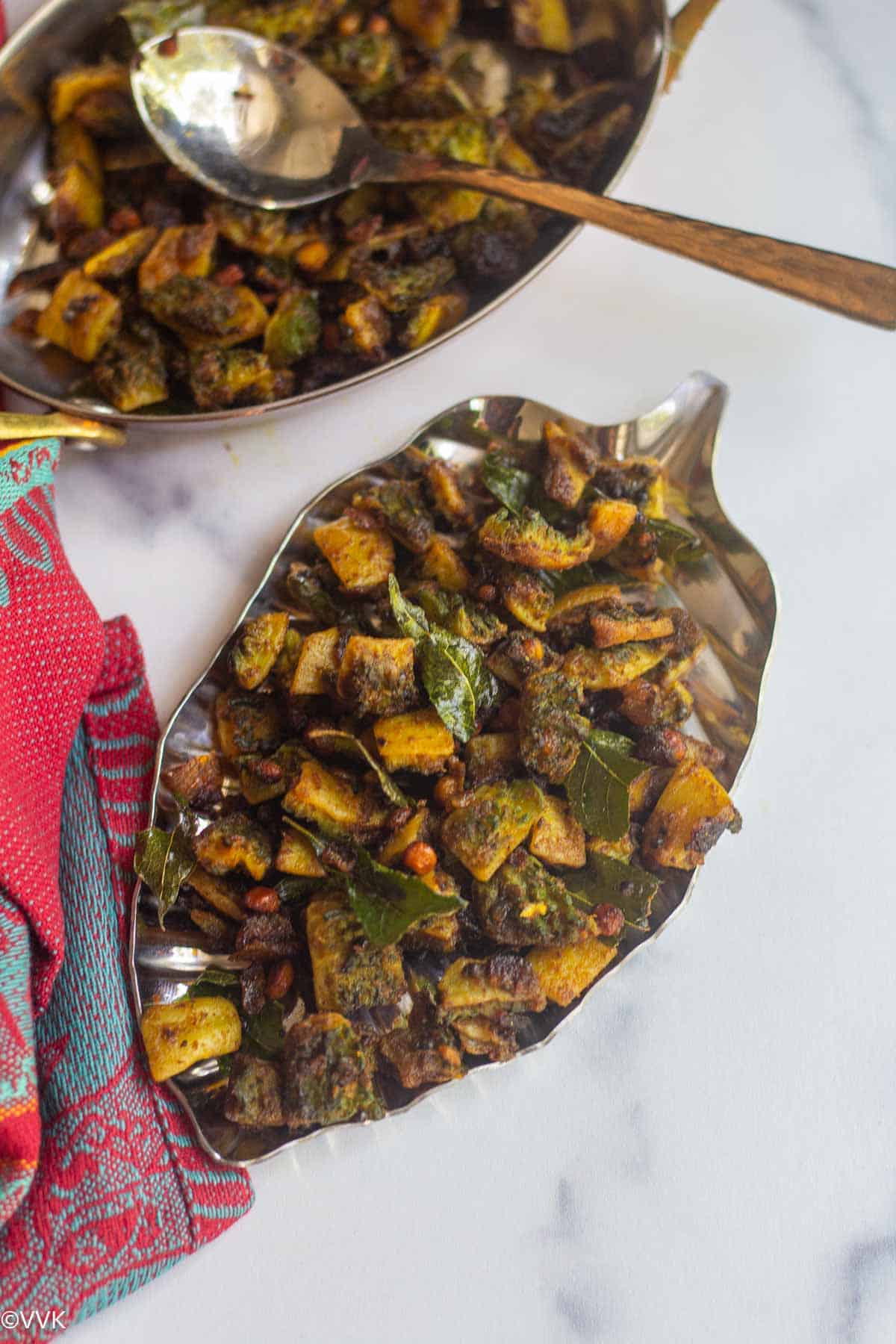
Ingredients needed
- Bitter gourd: I used the regular variety available at Indian grocery stores.
- Shallots: I used 7 Indian shallots for this poriyal. If you can’t find shallots, ¼ cup of chopped red onion works well.
- For tempering: You’ll need oil, mustard seeds, urad dal, and chana dal and curry leaves.
- Spices: I used sambar powder to add flavor, but you can also use red chili powder.
- Additionally, you’ll need turmeric powder, salt, and water. Please refer to the recipe card for exact measurements.
How to chop bitter gourd for the fry
For tender bitter gourd, I leave the spikes intact. I remove the spikes and trim the edges if it’s not tender. Cut the gourd lengthwise, scoop out the seeds with a spoon, and chop into bite-sized pieces. Do checkout my air-fryer bitter gourd chips where I have chopped them into rounds.
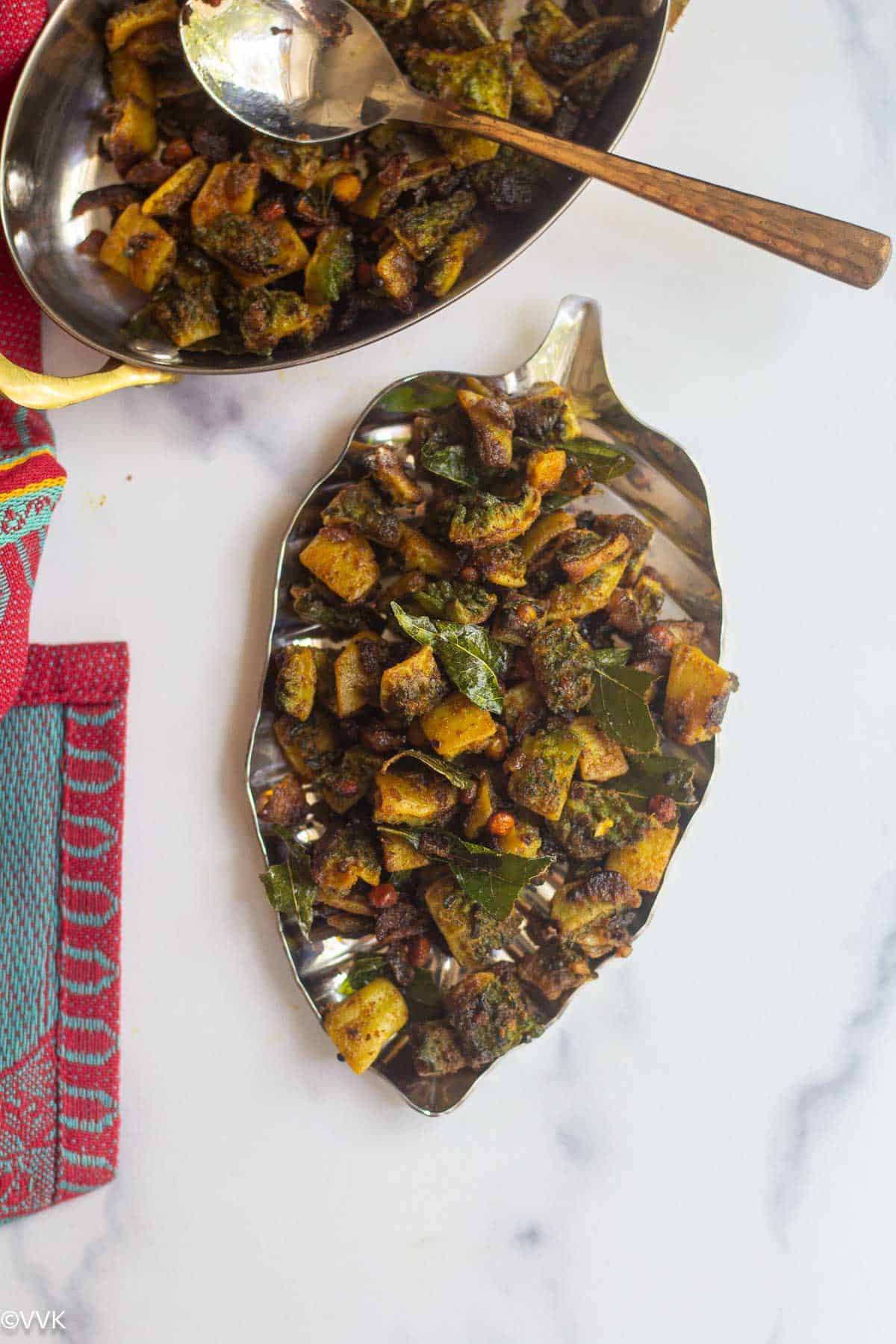
Dietary information and storage tips
This pavakkai poriyal is naturally vegan, gluten-free, and nut-free. For the best texture, enjoy it fresh. While it can be refrigerated for up to 3 days, it will soften over time. For meal prep, chop and steam the bitter gourd in advance and stir-fry it when ready to serve.
How to make crispy bitter gourd stir fry
- Chop the bitter gourd as described earlier and place it in a vessel suitable for a pressure cooker. Add 1.5 cups of water and ¼ tsp of turmeric powder, and pressure cook for one whistle.
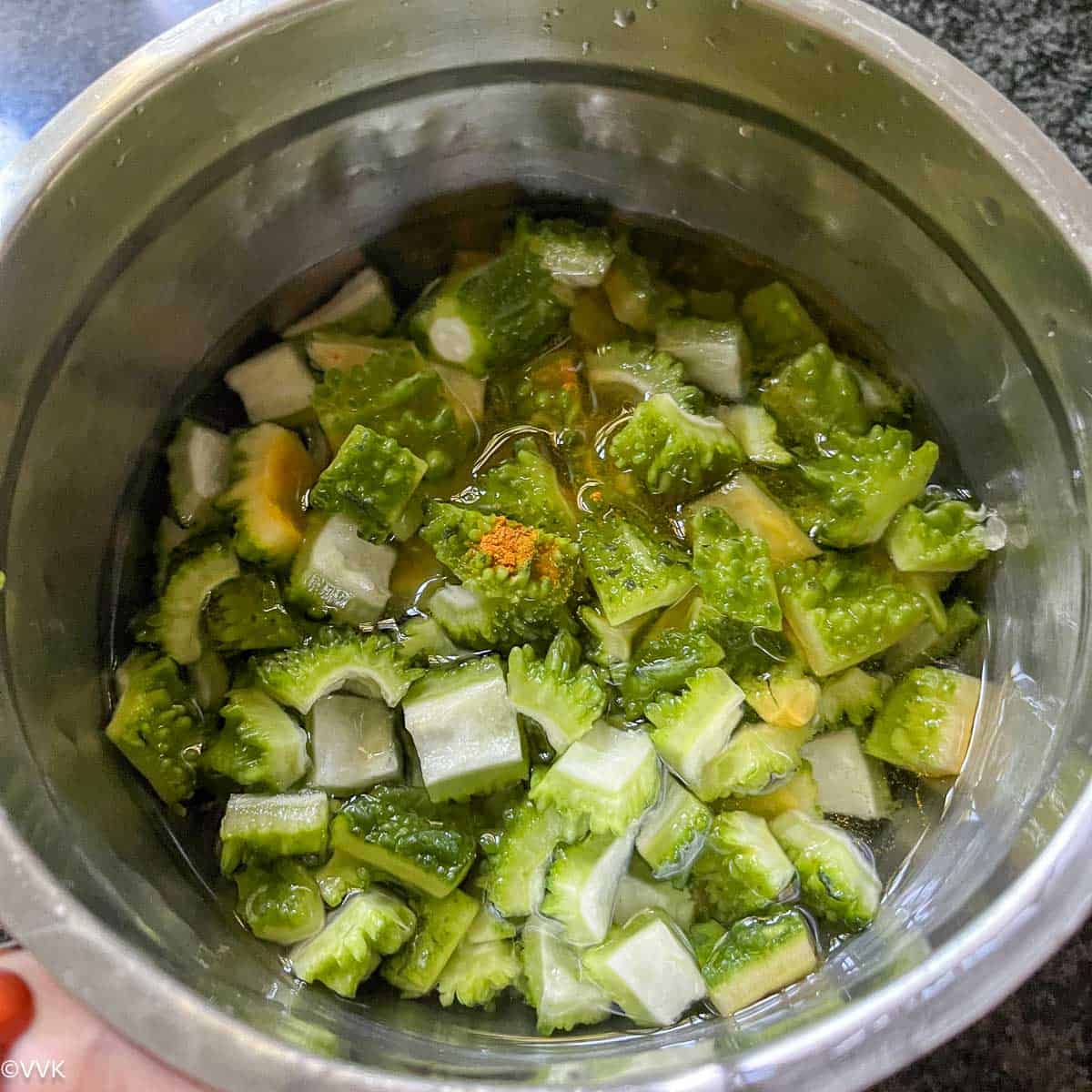
- Carefully release the pressure and drain the water.
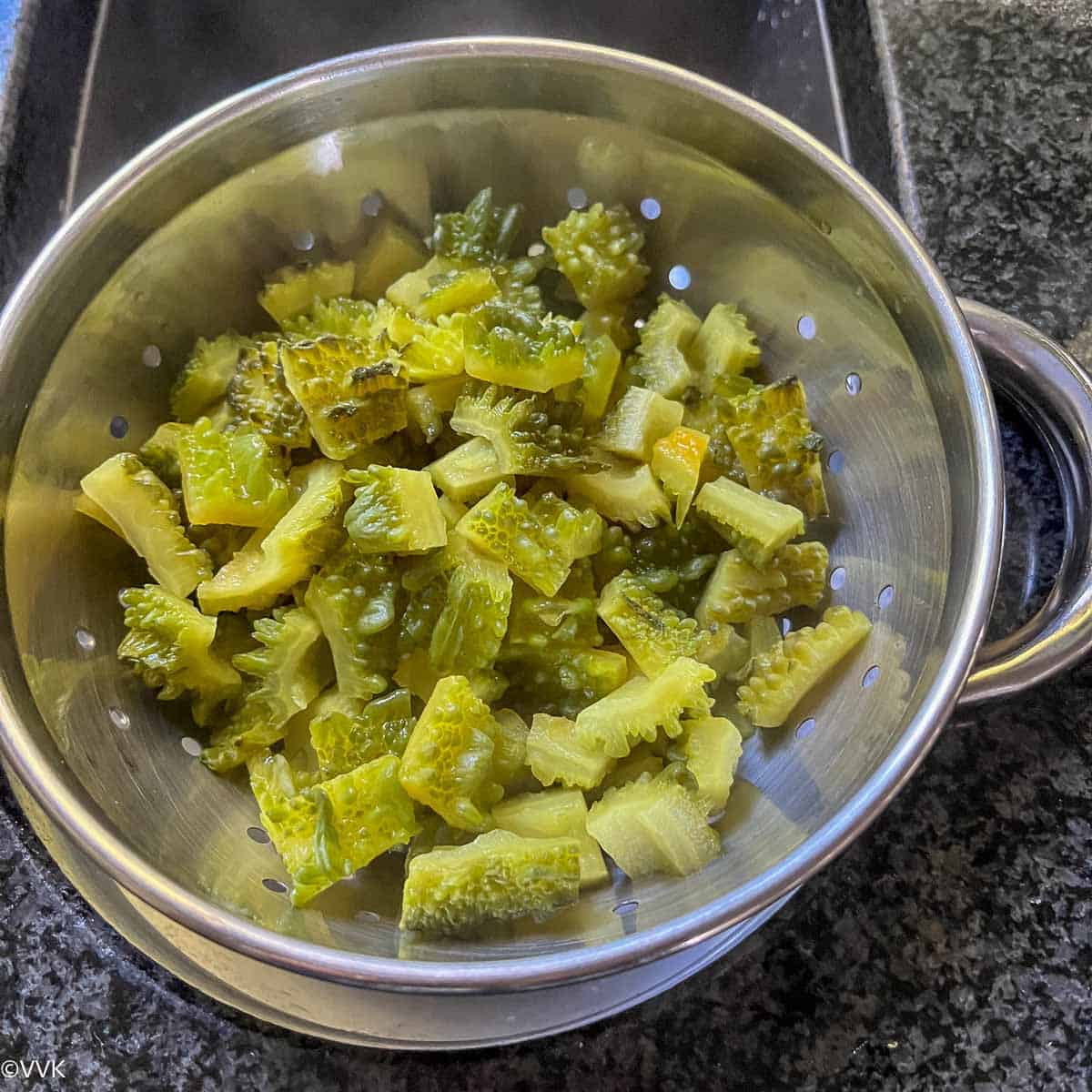
- Heat a cast iron pan and, once hot, add 1 tbsp of oil, spreading it evenly.
- Add mustard seeds, urad dal, and chana dal when the oil is hot.
- After the mustard seeds splutter, add the chopped shallots and curry leaves and cook until they turn translucent.
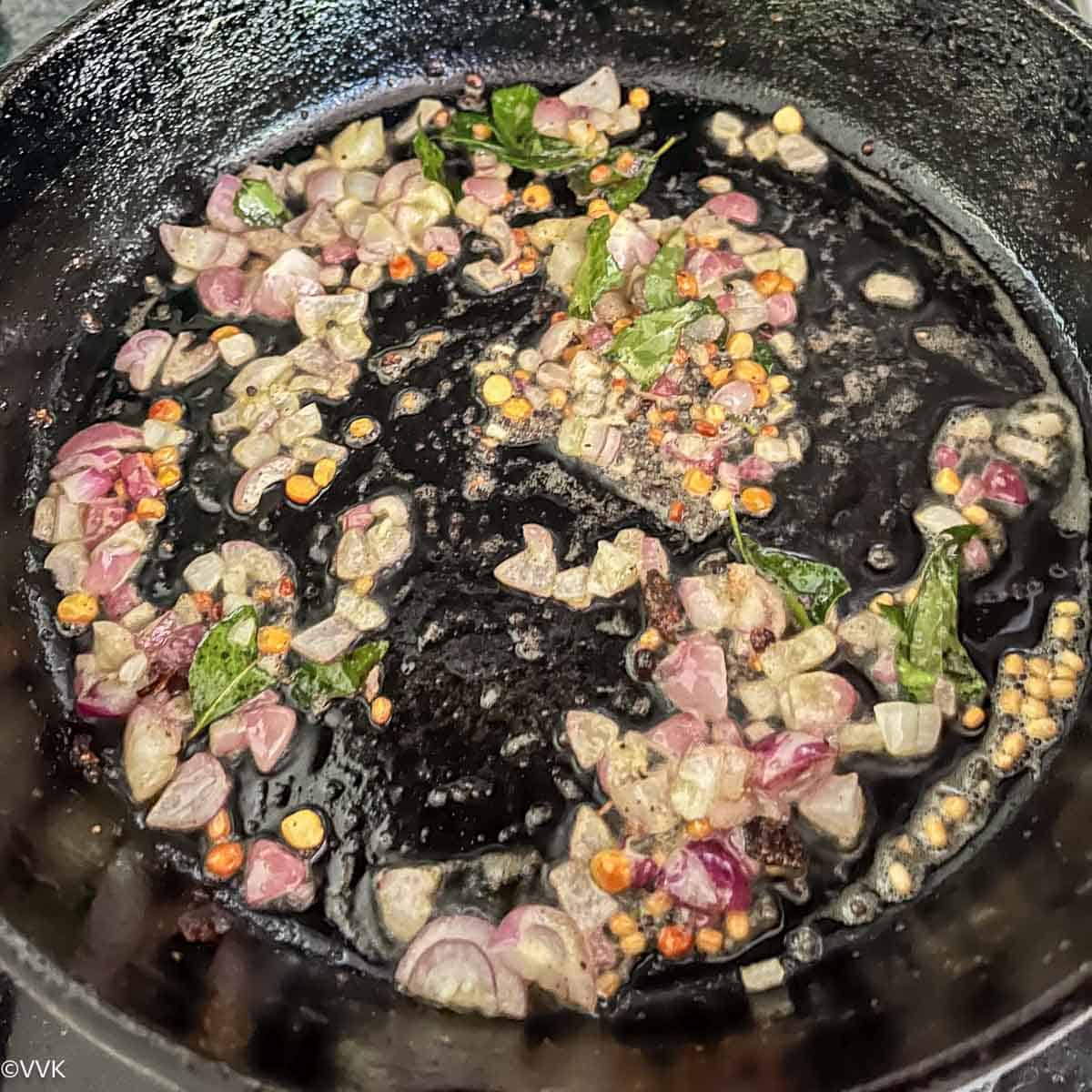
- Add the cooked bitter gourd, salt, and sambar or chili powder, mixing well.
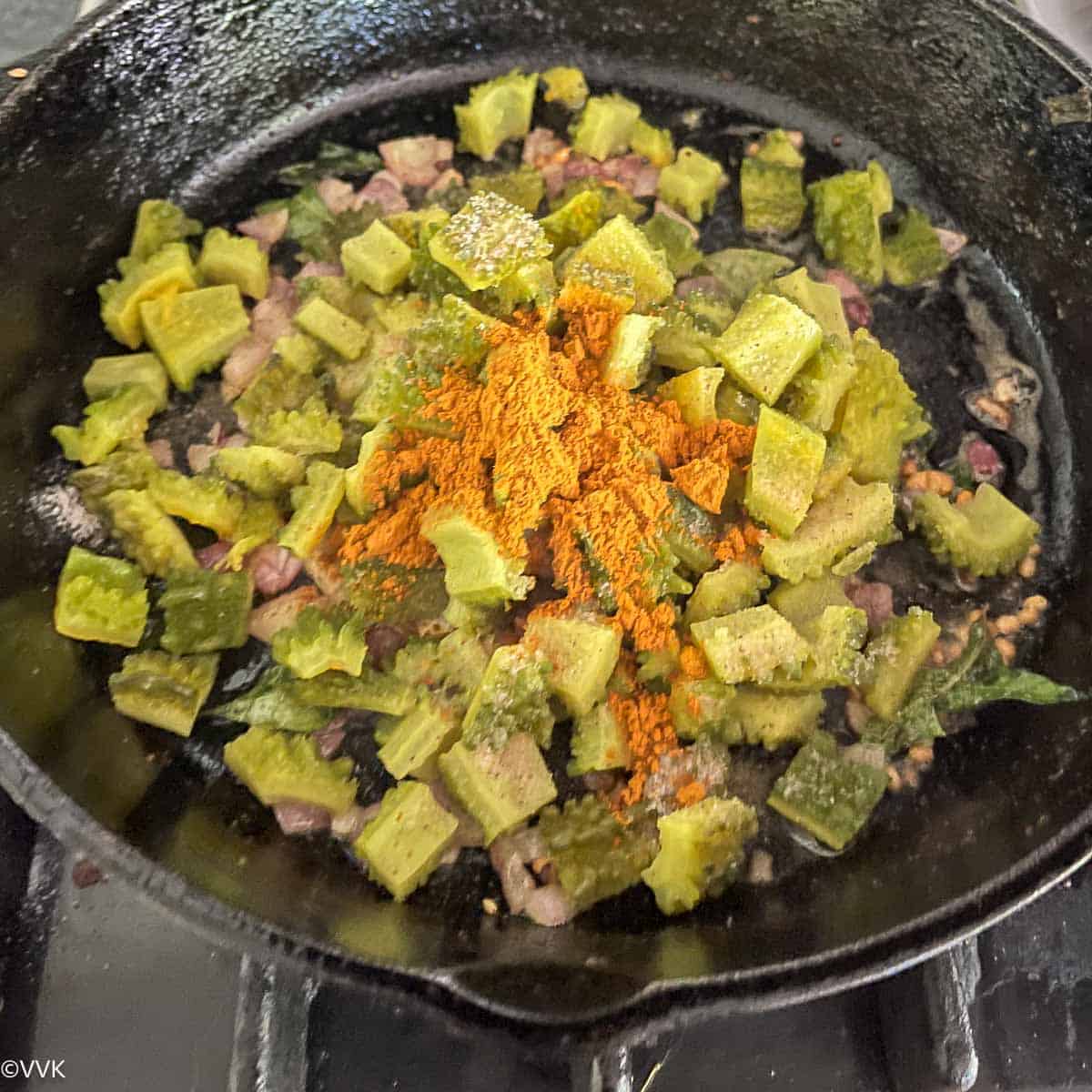
- Let it roast on low heat until all the moisture evaporates and a brown crust forms.
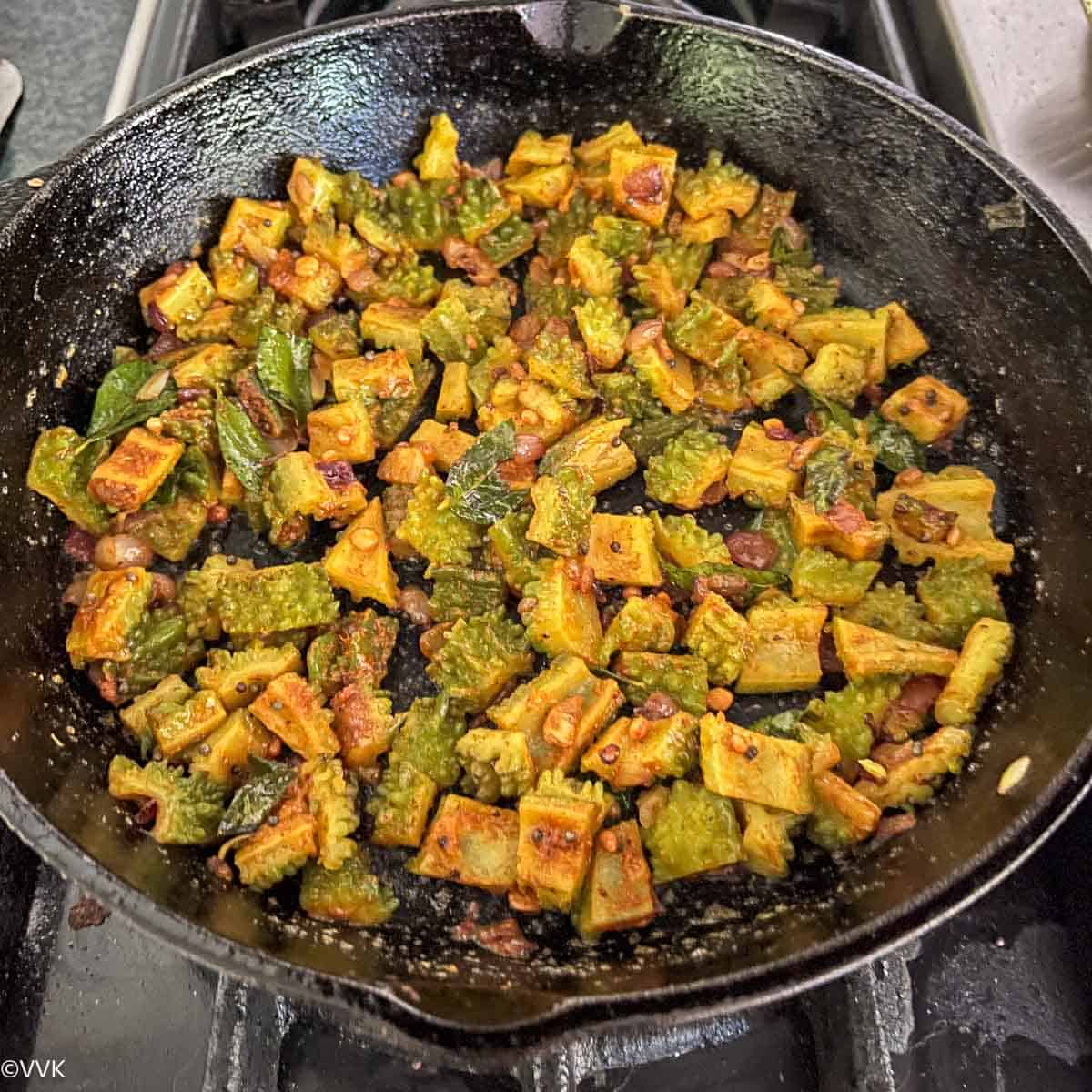
- Turn off the heat once the crust is formed and your crispy bitter gourd stir fry is ready.
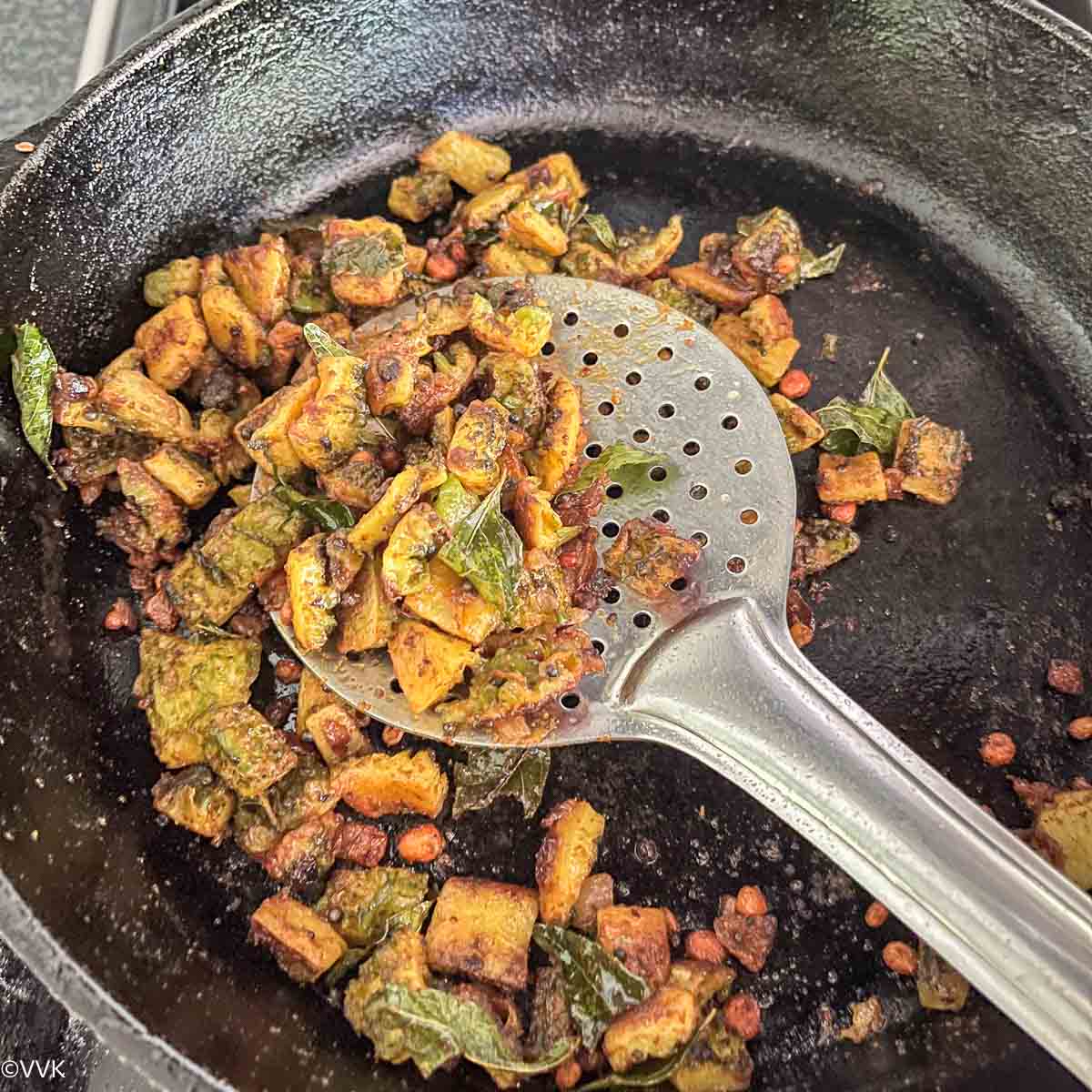
Tips for roasting bitter gourd in a cast iron pan
I love using a cast iron pan to roast vegetables. You can check out my recipes for ivy gourd and okra fry, both made on a cast iron pan. Here are some tips I follow for perfect results:
- Make sure your cast iron pan is well-seasoned.
- When adding oil, spread it evenly to coat the pan and prevent sticking.
- Don’t overcrowd the pan. Use about 90% of the pan’s capacity for even heat distribution and a nice crust without needing too much oil.
- While I didn’t use chickpea or rice flour in this recipe, they can help absorb moisture and make the veggies crispier.
- These tips always work for me! Feel free to share your tips in the comments.
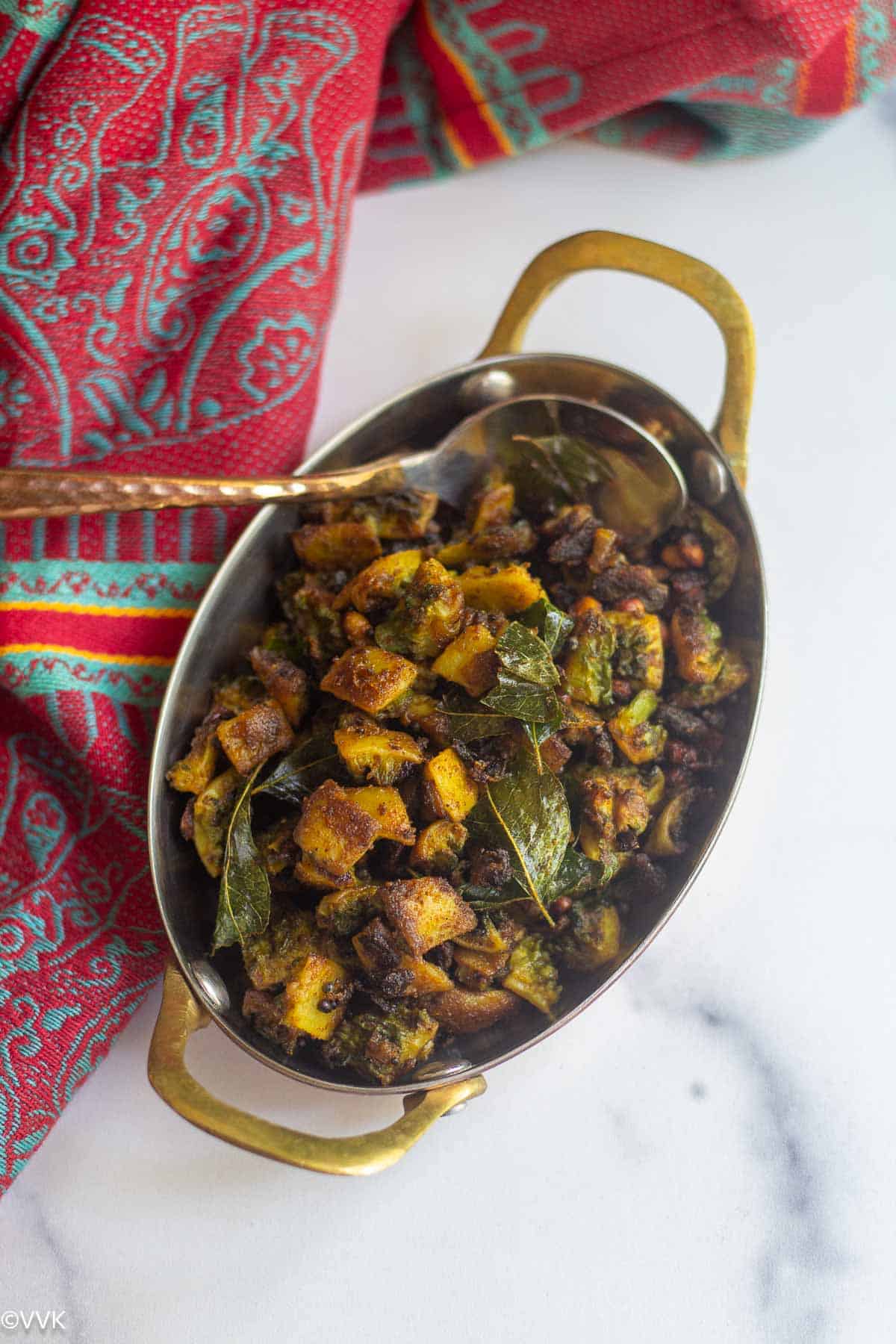
Recipe Notes
- Adjust the salt and spices to your taste.
- Why pressure cook the bitter gourd? I prefer steaming the veggies first to reduce the oil needed during frying. For bitter gourd, steaming also helps reduce some bitterness. I save the stock water and drink a couple of tablespoons.
- Alternative steaming methods: Instead of pressure cooking, microwave the bitter gourd for 6-7 minutes or use an Instant Pot on high pressure for one minute, followed by a quick pressure release.
- If you don’t have shallots, ¼ cup of chopped red onions can be used.
- You can use red chili powder or red chili powder + coriander powder in combination with sambar powder.
Explore more poriyal varieties
PS: If you try this pavakkai poriyal, please don’t forget to comment and rate this recipe. If you have any questions, please leave a comment, and I will get to it ASAP. Make sure to follow me on my Pinterest for more healthy and delicious ideas! Follow me on Instagram or join my Facebook Group for more recipe updates! You can also sign-up for my newsletter for weekly updates.
📖 Recipe
Pavakkai Poriyal | Crispy Bitter Gourd Stir Fry
Here is a simple South-Indian crispy bitter gourd stir-fry recipe that’s a perfect side dish for rice-based dishes! Check out how to make this simple pavakkai fry in a cast-iron pan with detailed step-wise pictures.
Servings: 4
Calories: 70kcal
Ingredients
Measurement Details: 1 cup=240ml; 1 tbsp = 15ml; 1 tsp = 5ml;
Instructions
-
Chop the bitter gourd as described earlier and place it in a vessel suitable for a pressure cooker. Add 1.5 cups of water and ¼ tsp of turmeric powder, and pressure cook for one whistle.
-
Carefully release the pressure and drain the water.
-
Heat a cast iron pan and, once hot, add 1 tbsp of oil, spreading it evenly. Add mustard seeds, urad dal, and chana dal when the oil is hot. After the mustard seeds splutter, add the chopped shallots and cook until they turn translucent.
-
Add the cooked bitter gourd, salt, and sambar or chili powder, mixing well.
-
Let it roast on low heat until all the moisture evaporates and a brown crust forms.
-
Turn off the heat once the crust is formed and your crispy bitter gourd stir fry is ready.
Notes
- Adjust the salt and spices to your taste.
- Why pressure cook the bitter gourd? I prefer steaming the veggies first to reduce the oil needed during frying. For bitter gourd, steaming also helps reduce some bitterness. I save the stock water and drink a couple of tablespoons.
- Alternative steaming methods: Instead of pressure cooking, microwave the bitter gourd for 6-7 minutes or use an Instant Pot on high pressure for one minute, followed by a quick pressure release.
- If you don’t have shallots, ¼ cup of chopped red onions can be used.
- You can use red chili powder or red chili powder + coriander powder in combination with sambar powder.
Nutrition
Calories: 70kcal | Carbohydrates: 8g | Protein: 2g | Fat: 4g | Saturated Fat: 0.3g | Polyunsaturated Fat: 1g | Monounsaturated Fat: 2g | Trans Fat: 0.01g | Sodium: 594mg | Potassium: 294mg | Fiber: 3g | Sugar: 3g | Vitamin A: 296IU | Vitamin C: 55mg | Calcium: 30mg | Iron: 1mg
I am not a nutritionist. The nutritional information is provided as a courtesy and is an estimate only. It varies depending upon the product types or brands.


